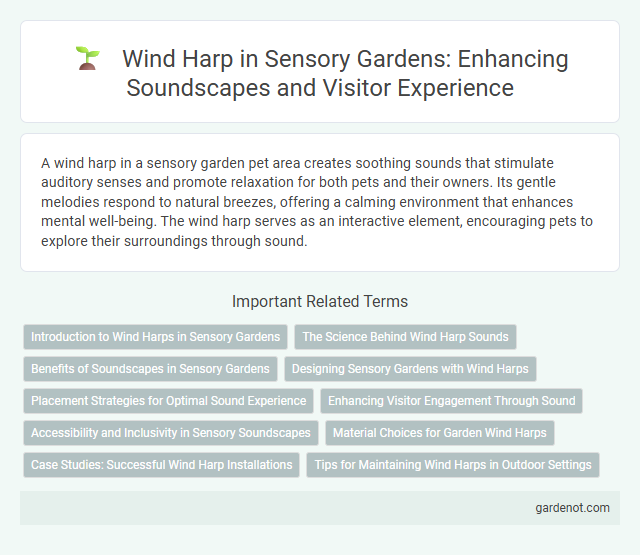A wind harp in a sensory garden pet area creates soothing sounds that stimulate auditory senses and promote relaxation for both pets and their owners. Its gentle melodies respond to natural breezes, offering a calming environment that enhances mental well-being. The wind harp serves as an interactive element, encouraging pets to explore their surroundings through sound.
Introduction to Wind Harps in Sensory Gardens
Wind harps harness natural airflow to produce melodic sounds that enhance the sensory experience in gardens. These instruments consist of strings or metal rods that vibrate with the wind, creating soothing harmonics that engage auditory senses. Integrating wind harps in sensory gardens promotes relaxation and connects visitors with the ambient environment through sound.
The Science Behind Wind Harp Sounds
Wind harp sounds are generated through the principle of aerodynamic vibration, where wind flowing across the harp's strings causes them to oscillate at specific frequencies. This phenomenon, known as vortex shedding, creates varying sound waves depending on wind speed and string tension. The resulting harmonic tones produce a natural, soothing auditory experience that reflects the interplay between physics and nature.
Benefits of Soundscapes in Sensory Gardens
Wind harps produce melodic sounds that enhance sensory gardens by creating soothing soundscapes, promoting relaxation and reducing stress. These natural auditory elements stimulate auditory perception and improve mood while encouraging mindfulness and connection with nature. Incorporating wind harps enriches the garden's multi-sensory experience, benefiting individuals with sensory processing challenges and improving overall well-being.
Designing Sensory Gardens with Wind Harps
Incorporating wind harps into sensory garden designs enhances auditory stimulation through natural wind-driven melodies, creating a calming atmosphere that engages visitors' senses. Strategic placement of wind harps near pathways and seating areas maximizes sound resonance, ensuring a dynamic interaction with environmental elements. Selecting materials like weather-resistant metal and tuning the harp's strings to harmonious frequencies optimizes acoustic performance and longevity in outdoor sensory garden settings.
Placement Strategies for Optimal Sound Experience
Positioning a wind harp in open, breezy areas enhances its sound resonance by allowing consistent airflow through the instrument's strings. Elevated locations, such as hilltops or raised platforms, maximize wind exposure and create clearer, more vibrant tones. Avoiding obstructive structures ensures the harp captures unobstructed wind patterns, optimizing acoustic performance in a sensory garden setting.
Enhancing Visitor Engagement Through Sound
Wind harps in sensory gardens create immersive auditory experiences by harnessing natural breezes to produce harmonious tones that captivate visitors. These instruments enhance visitor engagement through evolving soundscapes that stimulate auditory senses and encourage mindfulness and relaxation. Integrating wind harps promotes environmental awareness by connecting visitors with natural elements and the dynamic interplay of wind and sound.
Accessibility and Inclusivity in Sensory Soundscapes
Wind harps in sensory gardens enhance accessibility by offering tactile and auditory experiences for individuals with visual impairments. Their natural soundscapes create inclusive environments where diverse sensory needs are met through wind-generated melodies. This integration promotes engagement and therapeutic benefits, enriching the sensory garden's role as a multisensory space.
Material Choices for Garden Wind Harps
Wind harps crafted for sensory gardens often utilize sustainable materials like weather-resistant bamboo, stainless steel, and durable hardwoods to ensure longevity and rich acoustic resonance. These materials enhance the harp's harmonic tones by vibrating freely with the garden's gentle breezes, creating a soothing auditory experience. Selecting non-toxic and natural finishes promotes environmental harmony while maintaining aesthetic appeal and structural integrity in outdoor settings.
Case Studies: Successful Wind Harp Installations
Case studies of successful wind harp installations in sensory gardens reveal enhanced sensory engagement through natural soundscapes, notably improving visitor relaxation and auditory stimulation. Notable examples include the Vancouver Sensory Garden, where the wind harp integrates with native plants to amplify environmental harmony, and the Kew Gardens installation, which demonstrates durable design materials suited for diverse climates. These projects highlight the efficacy of wind harps in fostering immersive, multi-sensory outdoor experiences that support therapeutic and educational objectives.
Tips for Maintaining Wind Harps in Outdoor Settings
Regularly inspect wind harps for rust and wear, particularly in joints and strings exposed to moisture and wind. Apply weather-resistant coatings to metal and wooden components to prevent corrosion and decay. Securely anchor the harp to stable ground to withstand strong gusts and minimize vibrations that can damage the instrument over time.
Wind harp Infographic

 gardenot.com
gardenot.com